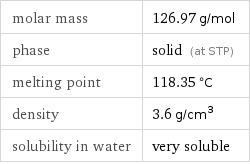Input interpretation

selenium trioxide
Chemical names and formulas

formula | SeO_3 Hill formula | O_3Se name | selenium trioxide alternate names | selenic anhydride mass fractions | O (oxygen) 37.8% | Se (selenium) 62.2%
Lewis structure

Draw the Lewis structure of selenium trioxide. Start by drawing the overall structure of the molecule, ignoring potential double and triple bonds: Count the total valence electrons of the oxygen (n_O, val = 6) and selenium (n_Se, val = 6) atoms: 3 n_O, val + n_Se, val = 24 Calculate the number of electrons needed to completely fill the valence shells for oxygen (n_O, full = 8) and selenium (n_Se, full = 8): 3 n_O, full + n_Se, full = 32 Subtracting these two numbers shows that 32 - 24 = 8 bonding electrons are needed. Each bond has two electrons, so in addition to the 3 bonds already present in the diagram we expect to add 1 bond. To minimize formal charge oxygen wants 2 bonds. Identify the atoms that want additional bonds and the number of electrons remaining on each atom: Add 1 bond by pairing electrons between adjacent highlighted atoms. Additionally, atoms with large electronegativities can minimize their formal charge by forcing atoms with smaller electronegativities on period 3 or higher to expand their valence shells. The electronegativities of the atoms are 2.55 (selenium) and 3.44 (oxygen). Because the electronegativity of selenium is smaller than the electronegativity of oxygen, expand the valence shell of selenium to 6 bonds. Therefore we add a total of 3 bonds to the diagram: Answer: | |
Basic properties

molar mass | 126.97 g/mol phase | solid (at STP) melting point | 118.35 °C density | 3.6 g/cm^3 solubility in water | very soluble
Units

Solid properties (at STP)

density | 3.6 g/cm^3
Units

Chemical identifiers
=O InChI identifier | InChI=1/O3Se/c1-4(2)3 EU number | 237-385-1 Gmelin number | 100832](../image_source/4b3fa2ab76b574dfdea8341eca2f9c95.png)
CAS number | 13768-86-0 PubChem CID number | 115128 SMILES identifier | O=[Se](=O)=O InChI identifier | InChI=1/O3Se/c1-4(2)3 EU number | 237-385-1 Gmelin number | 100832